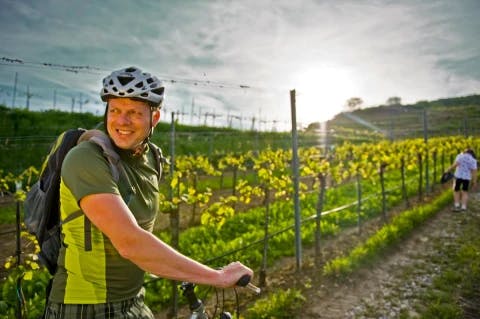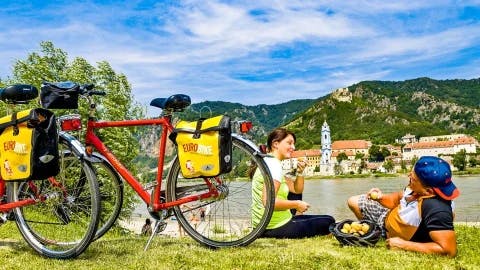Vienna is one of the most fascinating European capitals: thanks to its central position in Europe, it has been shaped by different cultural traditions that have left deep traces even in its gastronomy.
If you are wondering what to eat in Vienna, perhaps to celebrate the arrival of your bike trip along the Danube cycle path, you are in the right place.
Expect a mix of hearty dishes and delectable sweets with strong influences from Hungarian, Bohemian, and Jewish cuisine or created from improvised recipes that court chefs have developed to satisfy demanding emperors.
What to eat in Vienna: savory dishes

Viennese soups
Soups in Vienna are served as appetizers, but they are so hearty that they could be considered a main course.
The Frittatensuppe is one of the most loved and as you can guess from the name, it is nothing more than an omelette cut into thin strips and served in beef broth. It may sound extravagant, but it is not the most unusual culinary creation on the menus.
Beef, carrots, and onions are the magic ingredients of the Rindsuppe, even declared a national soup by the Austrians.
Other versions contain chicken, potatoes and milk, ricotta, pumpkin, tomato or white onions. There's something for everyone!
The dumplings
The dumplings, or semolina dumplings also widespread in South Tyrol, are a very versatile and appreciated dish in Vienna, where they are served in broth (grießnockerlsuppe), or filled with meat, vegetables, fish, and even a delicious sweet version.
The Goulash
Goulash is not typically Austrian, but it is one of those dishes to try at least once, even in Vienna, which offers one of the most tasty versions among all those from other Eastern European countries. It is a lean meat stew boiled in tomato sauce and often accompanied by dumplings, boiled potatoes or sour cream.
Wiener Schnitzel
Did Milanese cutlet or Wiener Schnitzel come first ? Who copied? It's said that it's the "fault" of the Austrian Marshal Josef Radetzky, but the Hamletic doubt about its origins will never be solved. It is certain that the Schnitzel is one of the undisputed symbols of Vienna and one of the dishes most appreciated by Viennese and tourists. Of pork or chicken, the breaded and fried cutlet is also very popular in the XXL version. Accompanied by french fries or potato salad, it's a real challenge to eat it all.
The Tafelspitz
The Tafelspitz may not look good, but Emperor Franz Joseph I was crazy about it. It's boiled beef or veal and so soft that it melts in your mouth, accompanied by apples, sauerkraut, potatoes or dumplings. Try it!
Beuschel e Backhendl: Offal sauce and fried chicken
Two complicated words to remember indicate two dishes born in the kitchens of the poor and then readapted even for the most demanding palates of aristocrats.
The Viennese Beuschel is a ragù of lung and veal offal accompanied by bread dumplings and sour cream sauce.
The Backhendl is nothing more than fried chicken. In addition to thighs, breast, and wings, 18th-century tradition calls for the addition of heart, liver, and stomach.
The Rostbraten
The Rostbraten is nothing other than roast beef. It is cooked in countless variants recognizable by the prefix in their name. The Zwiebelrostbraten is accompanied by onions, while the Girardirostbraten by mushrooms and capers. And the Vanillerostbraten? No, it has nothing to do with vanilla, but with a generous amount of garlic (once considered the "vanilla of the poor").
The Stephaniebraten
The Stephaniebraten is an oven-baked meatloaf stuffed with bread dumplings, boiled eggs, gherkins, spices, and sometimes even bacon and sausage. It was dedicated to Princess Stephanie of Belgium, who was not much loved by the Viennese. Perhaps they wanted to further discredit her by giving her name to a dish from poor cuisine. Considering the goodness of this meatloaf, however, they probably did not succeed.
The Sausages
The sausage is the most common street food in Vienna. Of pork, chicken, with cheese, served in slices with sauerkraut, mustard, and rye bread or in a long baguette: you cannot resist!
What to eat in Vienna: sweet temptations
We have already discussed this in part in our article on Austrian desserts, but given the high level of tastiness of the topic, we decided to revisit and expand it a bit. So we begin this chapter with the undisputed queen of Viennese pastry: Her Majesty the Sacher Torte.
The Sachertorte
It was invented by chance by the sixteen-year-old Franz Sacher when he had to replace the court cook and improvise a banquet for Prince Metternich and his guests. The dessert, made from sponge cake and chocolate glaze, and filled with apricot jam, was an immediate great success. The Sacher Hotel boasts of having the original recipe, but there are now many bakeries giving it competition.
The Strudel
The apple and raisin strudel is also a symbol of Viennese cuisine. Crunchy outside and soft inside, it's perfect when eaten while still warm accompanied by a scoop of vanilla ice cream. Try the version with apricots and quark (known as topfen in Austria) as well.
The Kaiserschmarren
The court chef to Franz Joseph I apparently got into big trouble when he burned the crepe for the Emperor's lunch. With no time to make a new one, he chopped it up and dusted it with powdered sugar. It was his lucky day! Francis Joseph appreciated it so much that he determined its name (Kaiser = emperor). Today it is served with raisins, rum, and blueberry jam. Delicious!
Sweet dumplings
Already mentioned earlier, the dumplings are also exquisite in the sweet version.
In Vienna, Marillenknödel are very popular, filled with apricots, but there are also varieties with a heart of chocolate or cherry jam, strawberries and plums or in vanilla sauce. They are usually served in portions of 3 and can be enough for a whole meal!
The Punschkrapfen
The Punschkrapfen is an inviting sweet born in Vienna but with uncertain origins, served in small bite-sized cube-shaped portions. It is unmistakable and attractive for the bright pink color of the sugar glaze that covers it. Inside is a sponge cake filled with apricot jam, chocolate, and rum. A real explosion of flavors.
We have whetted your appetite with all these incredible specialties? To try them all without feeling guilty, all you need to do is throw yourself into one of the many outdoor activities that the city offers, which we have told you about in the article about what to do in Vienna, or jump on the bike and continue your gastronomic journey through Austria and beyond. On Cyclando you will find dozens of routes, choose the one that's right for you and discover Europe in a sustainable way.





